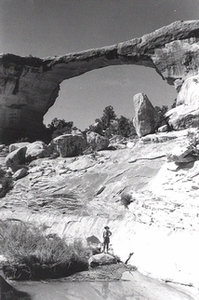NATURAL BRIDGES NATIONAL MONUMENT

Owachomo Bridge, Natural Bridges National Monument
Natural Bridges National Monument is located adjacent to Utah Highway 95 about forty miles west of Blanding. Its chief attractions are three immense water-carved natural bridges through necks and ridges of rock. They are Sipapu Natural Bridge, 220 feet in height and spanning 268 feet; Kachina Bridge, 210 feet high, with a span of 206 feet; and Owachomo Natural Bridge, 106 feet high, with a span of 180 feet.
A paved loop road circles the three bridges; from the road short trails extend to each of the bridges. Visitors may also walk a nine-mile circular trail, which for many years was the only access route. A National Park Service visitors center now offers information, maps, and souvenirs. The elevation at the visitors center is 6,505 feet.
Also found within the deep canyons are a number of small prehistoric cliff dwellings and storage rooms built by the Anasazi and then abandoned around A.D. 1100. When first visited by white men during the early 1880s, the land was sparsely occupied by Ute Indians. Cass Hite, a prospector who wandered into the area in 1883, was the first non-Indian to report the existence of what he termed "three whoppin' natural bridges."
Beginning about 1900, the bridges were often visited and popularized by authors, photographers, and painters who were guided into the canyons by local ranchers. In 1904 the National Geographic magazine sponsored an expedition to the area. By 1908 the bridges were sufficiently well-known for President Theodore Roosevelt to set aside the area as a national monument. The first dirt road was extended to the monument in 1928. Zeke Johnson, a well-liked canyon country guide and famous story teller, was monument superintendent in the 1940s.
The visitors center features a solar-power generating system that was designed by the Massachusetts Institute of Technology and was the world's largest at the time of its inauguration in 1980.
Disclaimer: Information on this site was converted from a hard cover book published by University of Utah Press in 1994. Any errors should be directed towards the University of Utah Press.